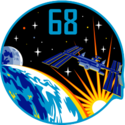Expedition 69
| Expedition 69 | |||
 | |||
| Uppdragsstatistik | |||
|---|---|---|---|
| Rymdstation: | ISS | ||
| Start: | 28 mars 2023 | ||
| Slut: | 27 september 2023 | ||
| Tid: | 182 dag, 21 tim, 57 min | ||
| Rymdpromenad | |||
| Antal rymdpromenader: | 8 st | ||
| Total tid: | 51 tim, 58 min | ||
| Transport | |||
| Uppskjutning: | med | ||
| Uppskjutningsplats: | Kosmodromen i Bajkonur Kennedy Space Center | ||
| Landning: | med | ||
| Landningsplats: | Kazakstan Atlanten | ||
| Kronologi | |||
| |||

Expedition 69 var den 69:e expeditionen till Internationella rymdstationen (ISS). Expeditionen började den 28 mars 2023 då den obemannade Sojuz MS-22 återvände till jorden.
Jasmin Moghbeli, Andreas Mogensen, Satoshi Furukawa och Konstantin Borisov anslöt till expeditionen den 27 augusti 2023.
Stephen G. Bowen, Warren Hoburg, Sultan Al Neyadi, Andrey Fedyaev lämnade expeditionen den 3 september 2023.
Oleg Kononenko, Nikolai Chub och Loral O'Hara anslöt till expeditionen den 15 september 2023.
Expeditionen avslutades den 27 september 2023 då Sojuz MS-23 lämnade rymdstationen.
Besättning
| Position | Första delen (28 mars - 27 augusti 2023) | Andra delen (27 augusti - 3 september 2023) | Tredje delen (3 - 15 september 2023) | Fjärde delen (15 - 27 september 2023) | |
|---|---|---|---|---|---|
| Befälhavare | Hans andra rymdfärd | ||||
| Flygingenjör | Hans första rymdfärd | ||||
| Flygingenjör | Hans första rymdfärd | ||||
| Flygingenjör | Hans fjärde rymdfärd | Hans femte rymdfärd | |||
| Flygingenjör | Hans första rymdfärd | Hans första rymdfärd | |||
| Flygingenjör | Hans första rymdfärd | Hennes första rymdfärd | |||
| Flygingenjör | Hans första rymdfärd | ||||
| Flygingenjör | Hennes första rymdfärd | ||||
| Flygingenjör | Hans andra rymdfärd | ||||
| Flygingenjör | Hans andra rymdfärd | ||||
| Flygingenjör | Hans första rymdfärd | ||||
Externa länkar
| |||||||||||||||||||||
Media som används på denna webbplats
Mission insignia for International Space Station (ISS) Expedition 68
The official Expedition 69 crew portrait
- The official Expedition 69 crew portrait with (from left) flight engineers Frank Rubio from NASA, Dmitri Petelin from Roscosmos, Sultan Alneyadi from UAE (United Arab Emirates), Woody Hoburg from NASA, Stephen Bowen from NASA, Andrey Fedyaev from Roscosmos, and Commander Sergey Prokopyev from Roscosmos.
Mission insignia for International Space Station (ISS) Expedition 69.
- The Expedition 69 patch reflects the mission of the International Space Station to enable long-term exploration of space, for the benefit of Earth. The unique mosaic design is inspired by the vintage, Art Deco stained glass window in Star City, Russia that provides a stylistic portrayal of the beauty of space exploration. The number "69" forms a circle to symbolize the international partnerships and collaboration that make the space station program possible. The Earth is the central element inside the "6" as our home planet and the primary beneficiary of research onboard space station. The star shining from Earth, spanning multiple continents, represents the ground teams around the world who support every aspect of this expedition and ensure our safe retum home. The space station itself signifies the contributions of thousands of people over the past several decades, whose vision and sustained efforts have made this miracle of a laboratory an unparalleled success. Looking towards the future, the next big steps in human space exploration are reflected in the Moon and Mars. The sun around Mars is symbolic of the human imagination, curiosity, and ingenuity that draws us to explore, The two white stars in the sky are taken directly from the Star City mural. The larger star represents the family and friends whose love and support makes this endeavor possible. The smaller star represents the explorers who came before us and helped pave the way to the stars.









